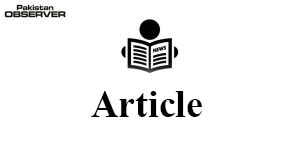Safe motherhood, save motherland
SINCE 74 years of independence, a struggle has been carried out; the very first program launched in Pakistan during first five years planning in 1958 was family planning, mother and child health.
The health structure designed in Pakistan is best infrastructure in ASIA and has been replicated by several neighbourhood countries.
Thousands of Non-Governmental Organizations are working on similar goals but the reality is still leaving many reservations.
Napoleon said “Give me an educated mother, I shall promise you the birth of a civilized, educated nation.”
The dream to build a stronger and sustainable Pakistan can only be fulfilled when the future of Pakistan is given all the possible services and facilities that provide them a secure, safe and reliable health care provision.
Although A female who is living in a rich culture, strong joint family system gives her optimum support. But at the same time various traditions, false and blind believes, tangled with myths and superstitious behaviour puts lives of both mother and child at a greater risk.
The provision of health care facilities, services, resources and governance as per UNICEF &World health Organization guidelines are under Process.
The reliability of government Institutions is accelerating gradually. The Government is putting best possible efforts by making all resources available to Improve and strengthen Health care delivery frame work.
While looking closely at the facts / statistics of Pakistan’s demographic and health indicators, it gives a very big surprise that after 2017 the health indicators improved dramatically which gives you an insight of the commitment by the government health policies and seriousness towards achieving sustainable development goals 2030. By all efforts the people of Pakistan are the ultimate beneficiaries.
This also indicates that Non-Governmental organizations and public private partnership has played its dramatic role in the recovery of scarcity of health care delivery and framework in renaissance of health care in Pakistan.
Pakistan’s Population growth rate: In 2020, population growth rate for Pakistan was 2 %. Population growth rate of Pakistan fell gradually from 2.7 % in 1971 to 2 % in 2020.Pakistan’sMaternal mortality ratio. In 2017, maternal mortality ratio for Pakistan was 140 deaths per 100,000 live births.
Between 2003 and 2017, maternal mortality ratio of Pakistan was declining at a moderating rate to shrink from 254 deaths per 100,000 live births in 2003 to 140 deaths per 100,000 live births in 2017.
Pakistan’s Neonatal mortality rate in 2019, neonatal mortality rate for Pakistan was 41.2 deaths per 1,000 live births.
Neonatal mortality rate of Pakistan fell gradually from 74.7 deaths per 1,000 live births in 1970 to 41.2 deaths per 1,000 live births in 2019.
Pakistan’s Infant mortality rate: In 2019, infant mortality rate for Pakistan was 55.7 deaths per 1,000 live births. Infant mortality rate of Pakistan fell gradually from 141.9 deaths per 1,000 live births in 1970 to 55.7 deaths per 1,000 live births in 2019.
Pakistan’s Under-five mortality rate, In 2019, child mortality rate for Pakistan was 67.2 deaths per 1,000 live births.
Child mortality rate of Pakistan fell gradually from 190 deaths per 1,000 live births in 1970 to 67.2 deaths per 1,000 live births in 2019. In 2019, life expectancy for Pakistan was 67.3 years.
Life expectancy of Pakistan increased from 52.6 years in 1970 to 67.3 years in 2019 growing at an average annual rate of 0.50%.
The sustainability of indicators and statistics to put the graph’s arrow more towards decline phase; needs people of Pakistan’s engagement and contribution towards safe motherhood to save motherland.
Level of health care from primordial, protection, prevention, early diagnosis and prompt treatment are very crucial and health promotion and health education plays the main key role in it; by enabling the people for informed decisions.
The only way to improve quality adjusted life years is “seeing is believing”; or by gaining early experience and knowledge from experts regarding the hazards, risks, complications of certain conditions, illnesses and diseases.
All health professionals and educated individuals can perform this health promotion awareness in their villages and UCs, as being responsible countrymen.
The importance of safe motherhood must be addressed by involvement of community leaders, teachers and Ulema.
Another way is to get a compact written draft regarding safe motherhood’s importance is to take guidelines university professors to be narrated to general community by Imam Masjid during Jummah Khutbah.
A compact certificate course before marriage can be initiated in Pakistan to educate both male and females; planning to start new life in next 6 months – one year or after; this will serve the purpose of Counselling, screening and relevant tests of partners for any hereditary disorders.
In Malaysia this certificate is early established; “Before marriage, every bride will have to attend the Pre-Marriage Courses organized by the State Religious Department or organized by companies appointed by the State Religious Department”.
(reference available with author). This can be linked to NADRA Registration and made available for all times to comes and for all authorities. In Short, Smart Moves are needed to build healthy Pakistan.
—The writer is contributing columnist, based in Rawalpindi.










